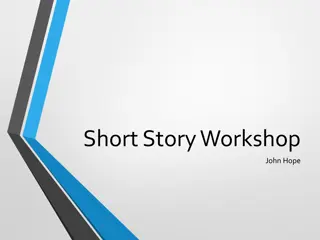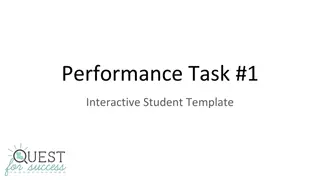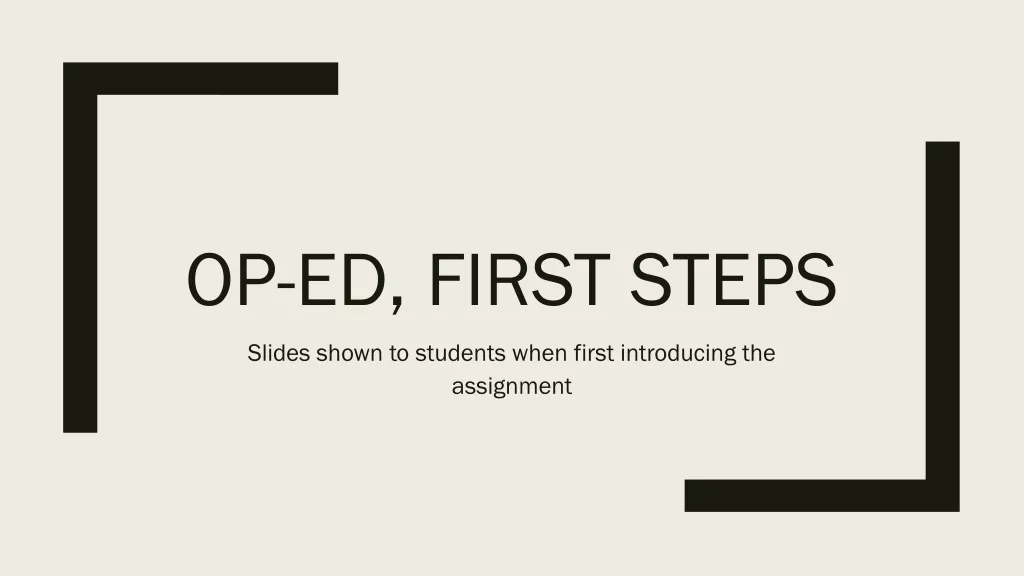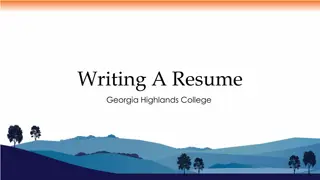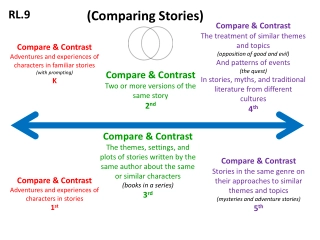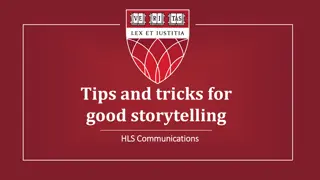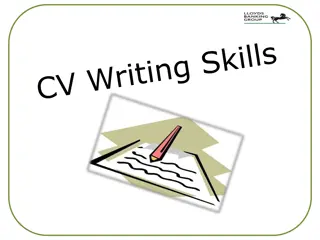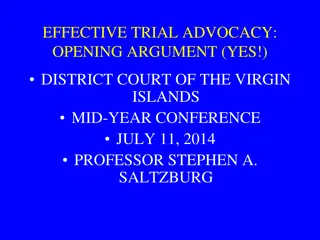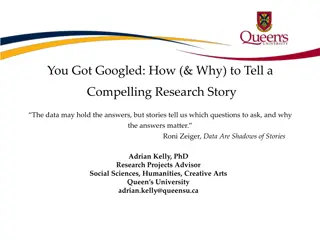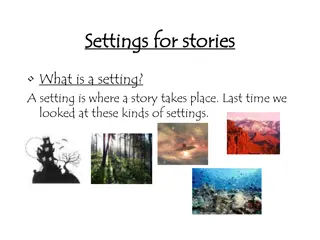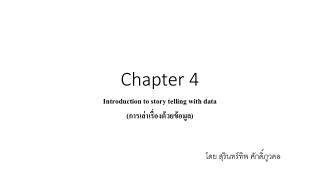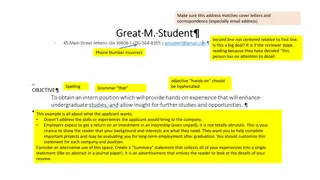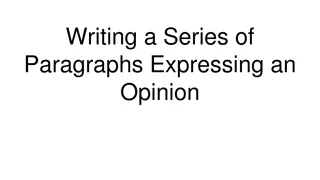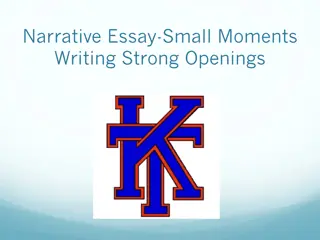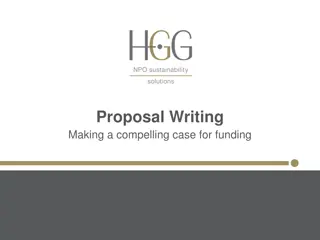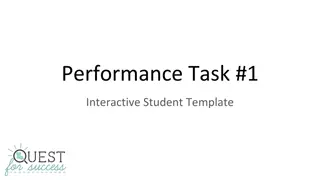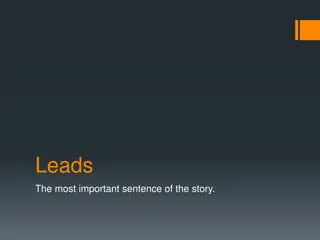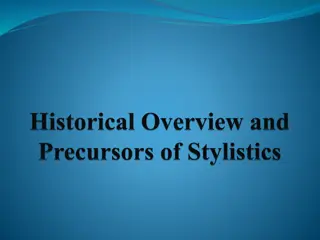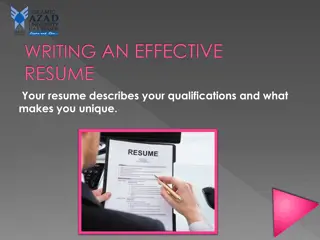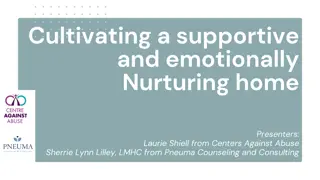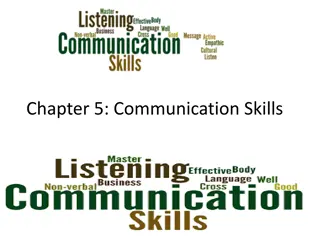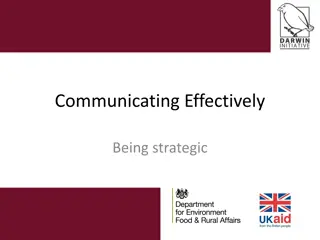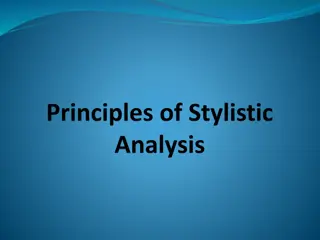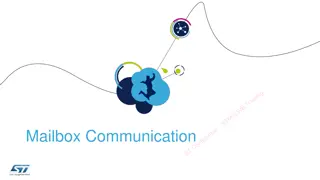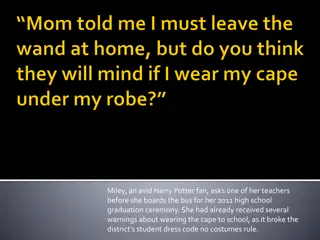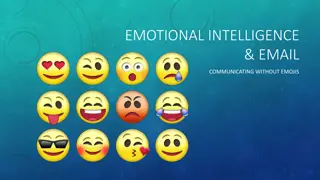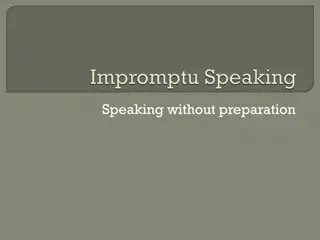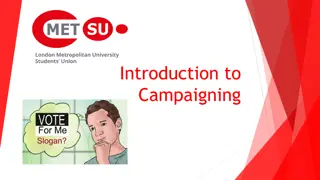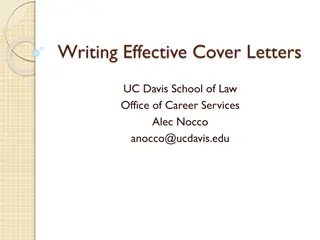Crafting Compelling Stories: A Guide to Effective Communication
Learn how to create impactful stories that engage and inspire your audience, with tips on defining objectives, brainstorming ideas, and structuring narratives for maximum impact. Discover the power of storytelling to convey messages, evoke emotions, and drive action.
Download Presentation

Please find below an Image/Link to download the presentation.
The content on the website is provided AS IS for your information and personal use only. It may not be sold, licensed, or shared on other websites without obtaining consent from the author. Download presentation by click this link. If you encounter any issues during the download, it is possible that the publisher has removed the file from their server.
E N D
Presentation Transcript
Story Selection Questions Answers for YOUR story A. Define objective What s your main message? What do you want your audience to think, feel, or DO as a result of your story? B. Brainstorm story ideas Think of relevant successes, failures, or moments of clarity (use story hunting tools) C. Can t think of one? Make one up Make sure your audience knows you made it up D. Choose the best one Pick the one that best delivers the main message All the same? Then pick one with most relatable hero, relevant challenge, and engaging struggle www.leadwithastory.com/resources Sell with a Story paul@leadwithastory.com paul@leadwithastory.com Download copies at: www.leadwithastory.com/resources Based on Sell with a Story, by Paul Smith
Case Study: Story Structure Template (20 Minutes) Step Answers the question: Sounds like... Notes on your story What do you want the audience to think, feel, or do after hearing your story? Objective/ Main Message (unspoken) I think the best example I ve seen of that was 1) Why should I listen to this story? Transition In: (Hook) 2) Where and when did it take place? 3) Who is the hero and what do they want? (Other background needed to understand characters motivations?) Back in ___, at ___, there was ____, and they were trying to (could be an unspoken objective) Context 4) What was the problem/opportunity? Then, one day ____. Challenge www.leadwithastory.com/resources Sell with a Story paul@leadwithastory.com paul@leadwithastory.com Download copies at: www.leadwithastory.com/resources Based on Sell with a Story, by Paul Smith
Case Study: Story Structure Template (20 Minutes) Step Answers the question: Sounds like... Notes on your story 5) What did they do about it? Show the honest struggle between hero and villain, even if internal. Can t be too easy So they ____, and then they ____, and so they ____. Conflict 6) How did it turn out (for everyone)? How are things/characters changed as a result? Resolution Eventually Transition Out: What I learned from that was (That s when I realized That explains why... What I think we should have done was ) 7) What did you learn? Lesson(s) 8) What do you think I should do? Recommended Action(s) And that s why I think you should www.leadwithastory.com/resources Sell with a Story paul@leadwithastory.com paul@leadwithastory.com Download copies at: www.leadwithastory.com/resources Based on Sell with a Story, by Paul Smith
Story Structure: Hook Questions Story spine: The best example of that I ve seen was. . . In what situation are you most likely to tell this story? Write a Hook to transition into this story. Don t apologize, ask permission, or announce a story . Just tell it. Answers the question: Why are you telling this story? Options to consider: I think the best example of that I ve seen was when . . . The best lesson I ever learned about that was when . . . That s a tough problem. Let me tell you what I did when I ran into the same issue last year . . . So, for instance, there was this one time when . . . It might be more clear if I just told you how some of my other clients have used that product . . . Let me help you understand what I m looking for . . . That reminds me of a time when . . . Something really important happened recently and I thought you d like to hear about it . . . www.leadwithastory.com/resources Sell with a Story paul@leadwithastory.com paul@leadwithastory.com Download copies at: www.leadwithastory.com/resources Based on Sell with a Story, by Paul Smith
Story Structure: Context Story spine: Back in ___, at ___, there was ____, and (s)he was trying to . . . Questions When and where? Who is the main character? Relatable to the audience: Hey! That could be me! (Y/N ___) What does the main character want? Before the Challenge? After the Challenge (if different)? Would audience deem these worthy objectives? (Y/N ___) Any other necessary background for the story to make sense, or to explain the characters motivations? www.leadwithastory.com/resources Sell with a Story paul@leadwithastory.com paul@leadwithastory.com Download copies at: www.leadwithastory.com/resources Based on Sell with a Story, by Paul Smith
Story Structure: Challenge and Conflict Story spine: (Challenge): Then one day . . . (Conflict): So (s)he ___, and then they ___, so (s)he ___ Questions CHALLENGE: what is the problem or opportunity that presents itself to the main character? Relevant to audience? (Y/N ___) Test: If you remove this part, nothing interesting would happen. CONFLICT: What did the main character do about it? In bullet point form, sketch out the chronological flow of what happened Show the honest struggle between hero and villain. Can t be too easy. Don t overlook internal struggle. Arrive late. Leave early. Come back and add or edit here based on ideas you develop in the sections on emotion, surprise, etc.
Story Structure: Resolution Questions Story spine: Eventually . . . How did it turn out in the end? For the hero, the villain, and any other main characters How were things changed as a result of the ordeal? Test: Does the audience know how to feel about what happened? If not, explain more. www.leadwithastory.com/resources Sell with a Story paul@leadwithastory.com paul@leadwithastory.com Download copies at: www.leadwithastory.com/resources Based on Sell with a Story, by Paul Smith
Case Study: Lesson and Action Story spine: (Lesson): What I learned from that was . . . (Action): And that s why I think you should. . . Questions Lesson: What did you learn? Transition out options: What I learned from that was. . . That s when I realized. . . So that explains why. . . I ve since come to realize. . . What I think we should have done was . . . Recommended Action: What do you think your audience should do now that they ve heard the story? This should link back to the reason why you told the story to begin with (the main idea) and compel audience to DO what you wanted it to do. www.leadwithastory.com/resources Sell with a Story paul@leadwithastory.com paul@leadwithastory.com Download copies at: www.leadwithastory.com/resources Based on Sell with a Story, by Paul Smith
Case Study: Emotion Questions Ideas for YOUR story A. Identify emotional moments: For each bullet point in your story outline, identify emotions the characters or audience should be feeling. B. Prioritize: Which ones will have the biggest impact on moving the audience to the desired outcome? C. Pick one or more techniques below to apply to the important ones: Dialog Use inner and outer dialog to show characters feelings. Tell me just state the emotion ( I was scared. ) Show me describe the behavior that demonstrates the emotion ( She was crying or He started yelling ) Make me feel Superior position creates tension and angst. Inferior position creates curiosity and anticipation. Equal position lets audience feel same emotions as characters. Let the audience get to know characters to avoid the Stormtrooper Effect. www.leadwithastory.com/resources Sell with a Story paul@leadwithastory.com paul@leadwithastory.com Download copies at: www.leadwithastory.com/resources Based on Sell with a Story, by Paul Smith
Surprise Questions Ideas for YOUR story Add surprise at the beginning to get the audience s attention, and at the end to make it more memorable Use this space to brainstorm ideas, then go back and add them to your story outline Use any or all of these techniques: Lead with the most unusual event Use flashback start with most surprising event, then backtrack to beginning. Skip one element in the Context and let your audience figure it out on their own. Create surprise ending - Move one key fact from the Context to the end. (Like James and the tea kettle) www.leadwithastory.com/resources Sell with a Story paul@leadwithastory.com paul@leadwithastory.com Download copies at: www.leadwithastory.com/resources Based on Sell with a Story, by Paul Smith
Dialog Questions Ideas for YOUR story Add outer dialog: Replace scenes where you describe what characters meant with what they actually said (even if you have to paraphrase). Make emotionally high potential moments stronger through actual dialog. Add inner dialog Where are your characters silent when inside they want to scream or cry? Share their inner monologue so we can hear what they re thinking at those moments. www.leadwithastory.com/resources Sell with a Story paul@leadwithastory.com paul@leadwithastory.com Download copies at: www.leadwithastory.com/resources Based on Sell with a Story, by Paul Smith
Details Questions Ideas for YOUR story Add details using these techniques: Replace generalities with specifics ( He was tall with He was 6 4 ) Show, don t tell ( Frank wrapped and unwrapped the telephone cord around his finger shows he s nervous.) Pick one important scene and describe it in vivid detail Use metaphors (A looming deadline is dark cloud or gun to my head ) Give details only when it s relevant to the Conflict or explains a main character s motivations. (No it was a warm September morning. . . ) www.leadwithastory.com/resources Sell with a Story paul@leadwithastory.com paul@leadwithastory.com Download copies at: www.leadwithastory.com/resources Based on Sell with a Story, by Paul Smith
Length Questions Ideas for YOUR story Length Leadership stories generally range from 2 - 5 minutes (300 750 words). Does yours fit this range? Sales stories average 2 minutes (300 words) and generally range from 1- 3 minutes (150-450 words). Does yours fit this range? To shorten a story use Story Structure Template (Appendix C) and eliminate least critical part of each section, while leaving some content in each section. www.leadwithastory.com/resources Sell with a Story paul@leadwithastory.com paul@leadwithastory.com Download copies at: www.leadwithastory.com/resources Based on Sell with a Story, by Paul Smith
Delivery Questions Ideas for YOUR story Oral Delivery Relax the story is more important than the delivery. A perfect delivery is not perfect 5 or 6 filler words a minute is okay. Don t slip into storytelling voice stay in same conversational tones. Focus on the story, not your physical performance. Written Delivery Write the way you d like to speak conversational, but without all the filler words. Use short sentences 15-17 words per sentence. Use simple words - <10% greater than 2 syllables. Use active voice - <10% passive voice sentences. Get to the verb quickly in the first 5- 6 words of each sentence. Flesch-Kincaid grade level: Target score of 7-8 (like John Grisham or Tom Clancy) www.leadwithastory.com/resources Sell with a Story paul@leadwithastory.com paul@leadwithastory.com Download copies at: www.leadwithastory.com/resources Based on Sell with a Story, by Paul Smith
Stretching the Truth Questions Ideas for YOUR story Check your story for fidelity to the truth with these guidelines A. Accuracy is important. Precision is not. Don t be afraid to use specific quotes and details. B. Don t embellish stories any more than you would embellish facts. Set expectations up front about how factually precise the story will be. I saw something interesting this morning. . . suggests high precision. I once heard about a guy who. . . suggests low precision. Litmus test - Imagine someone who listened to your story was actually there when it happened. Would they be offended? And would you be embarrassed? If yes to either of those, you ve probably changed too much. If not, you re fine. Hard points (don t change these): event, challenge, process to overcome, resolution, lesson learned. Soft points (more leeway): time, location, names and descriptions of people, re-sequencing events, quotes, dialog. www.leadwithastory.com/resources Sell with a Story paul@leadwithastory.com paul@leadwithastory.com Download copies at: www.leadwithastory.com/resources Based on Sell with a Story, by Paul Smith
Practice and Save Questions Ideas for YOUR story Practice Don t fully script your story unless it will be delivered in writing. Outline it, using the Story Structure Template. Don t memorize your story word for word, so you can deliver it extemporaneously each time. Practice options 1) Walk and talk with an imaginary friend, 2) live audience, 3) audio recording, 4) video recording, 5) online services. (Avoid the mirror). Save Database your story using Story Database (www.leadwithastory.com/resources) , Microsoft Word file, PowerPoint, Online story database services, audio or video recording. www.leadwithastory.com/resources Sell with a Story paul@leadwithastory.com paul@leadwithastory.com Download copies at: www.leadwithastory.com/resources Based on Sell with a Story, by Paul Smith


